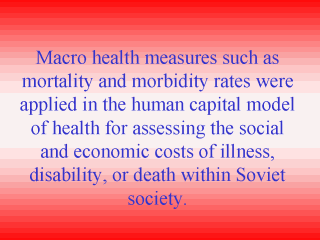 |
This approach
linked health and the production process, placing a monetary value on human life. The
value of saving or increasing the quality of life was measured in direct and indirect
costs to gross domestic income due to premature loss of human life and future earnings.
The socialized state valued the individual based on the extent of individual contributions
of labor to the state, which could be lost through illness or death. Cutting such losses
and obtaining more accurate assessments of the need for, and provision of, curative and
preventive health services were the fundamental goals of the five-year health plans. The
model of human capital in health planning was not only widely used in the Soviet Union for
prioritizing resource allocation in the health care system, but was also popular in the
1970s among health planners in the United States, Canada, and the United Kingdom (Black
and Pole, 1975; Mushkin and Dunlop, 1979; Rice, 1967). |
